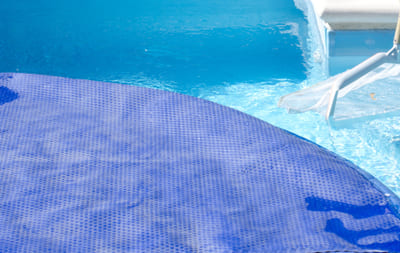Solar Pool Cover Heating Cost Savings
Article posted by Gregory Grochola (physicist) on 6th Mar 2019
In this article we analyze auxiliary pool heating cost savings from the use of solar pool covers (otherwise known as pool blankets). A lot has been said on the subject with some tentative numbers supplied on the internet like "pool covers can save 50-80%", but are these numbers accurate and what are the governing factors? Will you save 50% or all of 80%. Let's look at what the actual science says as it does depend on the climate of the area in question.
All of this data was gathered from calculations performed using our new heat loading calculator (validated against the heat loading standards AS 3634-1989 and ISO TR 12596 1995 here).

From our analysis we can tell you straight off THE governing factor determining how much you'll save is the evaporation rate in your area. And this factor scales exponentially with pool water and air temperatures. The higher the average temperatures in your capital the more evaporation, the greater the saving you're going to see from a pool cover. Let's have a look at the details.
A word of caution here: all the below calculations are for the blue, bubble style transparent blankets. Darker blankets will not be anywhere near as good in terms of energy conservation as they block the sun and cool the pool (Czarnecki, CSIRO TR19, 1978).
We'll calculate saving for an average pool first; by average we mean average heat loadings, i.e., average wind speed, average wind sheltering, light pool walls, with 0% shading on pool. Were we'll compare no pool cover use (0%) to a pool covered 87.5% of the time. We use 87.5% as that's a more realistic percentage if you're actually using a pool. 100% would be more for an unused pool. We'll then try varying the heat loading conditions to a wind exposed pool and a 100% shaded pool to see if the savings from a pool cover increase or decrease under those conditions. We'll do this for two different season lengths to examine this also. Before we get into it, let's define how we performed the calculations.
Calculation Definitions and Data Used
Heating Season Length
We calculated two extreme swimming season lengths - some people use their heaters year-round while others are more conservative and may only heat during a standard swimming season (or even less). Knowing this range allows you to get a good idea of the savings if you choose to run your heating somewhere in between these two limits.
Year-round heating means we ran the heater year-round of course, while a standard solar heating season was defined as what you'd get from a well sized solar pool heating system:
Standard Solar Season Heating Month Definitions
* if required
Pool Heat Loading Scenarios
We show results for: an average pool, a wind exposed pool and a 100% shaded pool to see what effects these factors have on pool cover savings; these are defined as follows:
Average Pool
- Average suburban setting - pool has average wind sheltering
- No shading on pool
Wind Exposed Pool
- Open windy area with pool fully exposed to the wind - little structures around the pool
- No shading on pool
Shaded Pool
- Average suburban setting - pool has average wind sheltering
- 100% shading on the pool
So that the only difference between the average pool and the wind exposed pool is the wind level, and the only difference between the average pool and the shaded pool is the shading level.
Pool Temperatures Used
The pool temperatures used for each state are 29°C for Hobart, Melbourne, Canberra, Sydney, Perth and Adelaide, 31°C for Brisbane and 33°C Darwin.
How We Defined "Running Costs Savings"
In the tables that follow, "Running Costs Savings" are defined as - 1st year energy cost ONLY. These are saving in running costs ONLY - they do not include heater unit replacement or maintenance cost.
Pool Cover Heating Running Cost Savings
Year-round Heating
Standard Pool Heating Season
Summary
So what does the data show? Firstly, the main finding is that the greatest savings are going to be for high temperature climates like Darwin, Brisbane and Perth, as they have the highest evaporation rates. Hobart and Melbourne have significantly smaller savings from pool covers. Findings summary:
- for year-round heating solar pool covers can result in savings of 52% to 86% energy costs for an average pool (Hobart to Darwin) dependent on climate temperature.
- surprisingly we found the pool's wind exposure - while having one of the greatest effects on heating costs, did not alter the % savings from pool blanket usage much as we would have expected.
- shading, on the other hand, will hammer the potential savings from a pool blanket; for 100% shading, savings drop to 44% - 51% (Hobart to Darwin)
- a shorter swimming season increases pool cover savings to: 64% to 86% (Hobart - Darwin) for an average pool, greatest effect is observed for the Southern Australian states.
So there you have it, warmer states will see the greatest benefit from a pool cover. Shading on a pool will greatly reduce potential saving from a blanket, as it removes that extra free heat input from the sun which blankets lock into place. The big lesson here is to remove shading on a pool if you can, not only will it cut heating costs, but it'll boost the performance of a pool cover, hence it'll multiplicatively reduce heating costs.
If you have a specific set of heat loadings on your pool, try our online pool heating running cost calculator. Auxiliary heaters can get expensive fast without solar covers, so it's well worth spending some time playing around with the calculator trying different settings.
If you enjoy this article please share, it'll help us get the word out about solar and renewables :)

